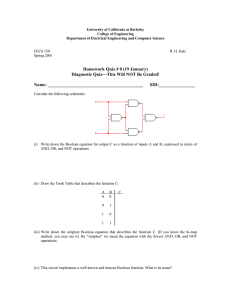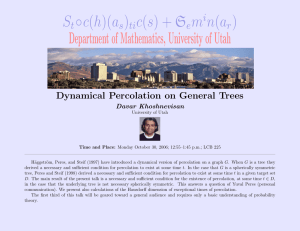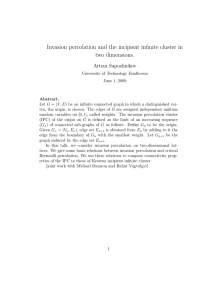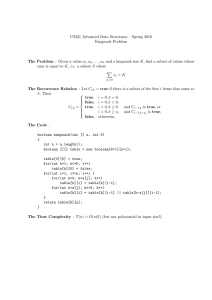percolation.ppt
advertisement
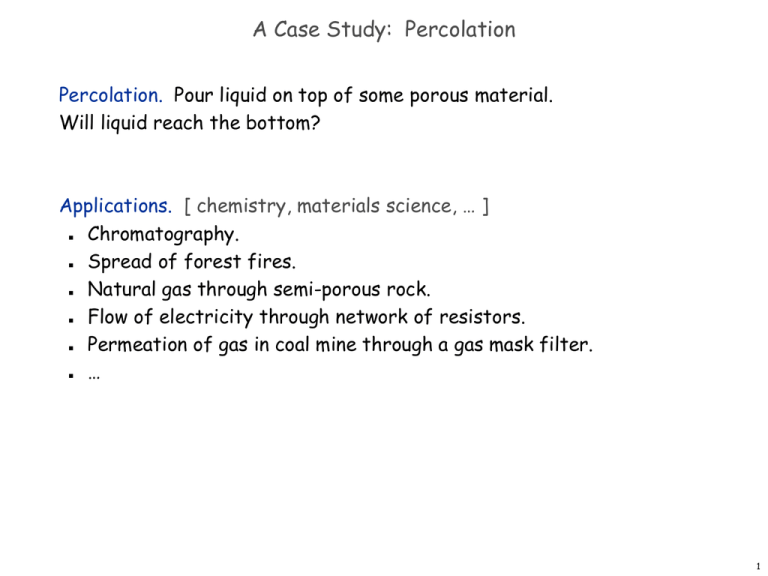
A Case Study: Percolation
Percolation. Pour liquid on top of some porous material.
Will liquid reach the bottom?
Applications. [ chemistry, materials science, … ]
Chromatography.
Spread of forest fires.
Natural gas through semi-porous rock.
Flow of electricity through network of resistors.
Permeation of gas in coal mine through a gas mask filter.
…
1
A Case Study: Percolation
Percolation. Pour liquid on top of some porous material.
Will liquid reach the bottom?
Abstract model.
N-by-N grid of sites.
Each site is either blocked or open.
blocked site
open site
2
A Case Study: Percolation
Percolation. Pour liquid on top of some porous material.
Will liquid reach the bottom?
Abstract model.
N-by-N grid of sites.
Each site is either blocked or open.
An open site is full if it is connected to the top via open sites.
blocked site
full site
open site
percolates
(full site connected to top)
does not percolate
(no full site on bottom row)
3
A Scientific Question
Random percolation. Given an N-by-N system where each site is vacant
with probability p, what is the probability that system percolates?
p = 0.3
(does not percolate)
p = 0.4
(does not percolate)
p = 0.5
(does not percolate)
p = 0.6
(percolates)
p = 0.7
(percolates)
Remark. Famous open question in statistical physics.
no known mathematical solution
Recourse. Take a computational approach: Monte Carlo simulation.
4
Data Representation
Data representation. Use one N-by-N boolean matrix to store which
sites are open; use another to compute which sites are full.
blocked site
open site
8
0
1
1
0
0
0
1
1
8
0
0
1
0
1
1
0
1
1
0
1
1
1
0
1
1
1
1
0
1
1
0
0
1
1
1
0
0
0
0
1
0
0
1
1
1
1
0
1
1
0
1
1
1
1
1
1
0
0
1
0
1
0
1
1
0
shorthand:
0 for blocked, 1 for open
open[][]
5
Data Representation
Data representation. Use one N-by-N boolean matrix to store which
sites are open; use another to compute which sites are full.
Standard array I/O library. Library to support reading and printing 1and 2-dimensional arrays.
8
0
0
0
0
0
0
0
0
full site
8
0
0
0
0
0
0
0
0
1
0
0
0
0
0
0
0
1
1
0
0
0
0
0
0
1
1
0
0
0
0
1
0
0
1
1
1
1
0
1
1
0
1
1
1
1
1
1
0
0
1
0
1
0
1
1
0
shorthand:
0 for not full, 1 for full
full[][]
6
Vertical Percolation
Next step. Start by solving an easier version of the problem.
Vertical percolation. Is there a path of open sites from the top
to the bottom that goes straight down?
7
Vertical Percolation
Q. How to determine if site (i, j) is full?
A. It's full if (i, j) is open and (i-1, j) is full.
Algorithm. Scan rows from top to bottom.
row i-1
row i
8
Vertical Percolation
Q. How to determine if site (i, j) is full?
A. It's full if (i, j) is open and (i-1, j) is full.
Algorithm. Scan rows from top to bottom.
public static boolean[][] flow(boolean[][] open) {
int N = open.length;
boolean[][] full = new boolean[N][N];
for (int j = 0; j < N; j++)
full[0][j] = open[0][j];
initialize
for (int i = 1; i < N; i++)
for (int j = 0; j < N; j++)
full[i][j] = open[i][j] && full[i-1][j];
find full sites
return full;
}
9
Vertical Percolation: Testing
Testing. Add helper methods to generate random inputs and
visualize using standard draw.
public class Percolation {
...
// return a random N-by-N matrix; each cell true with prob p
public static boolean[][] random(int N, double p) {
boolean[][] a = new boolean[N][N];
for (int i = 0; i < N; i++)
for (int j = 0; j < N; j++)
a[i][j] = StdRandom.bernoulli(p);
return a;
}
// plot matrix to standard drawing
public static void show(boolean[][] a, boolean foreground)
}
10
General Percolation: Recursive Solution
Percolation. Given an N-by-N system, is there any path of open sites
from the top to the bottom.
not just straight down
Depth first search. To visit all sites reachable from i-j:
If i-j already marked as reachable, return.
If i-j not open, return.
Mark i-j as reachable.
Visit the 4 neighbors of i-j recursively.
Percolation solution.
Run DFS from each site on top row.
Check if any site in bottom row is marked as reachable.
11
Depth First Search: Java Implementation
public static boolean[][] flow(boolean[][] open) {
int N = open.length;
boolean[][] full = new boolean[N][N];
for (int j = 0; j < N; j++)
if (open[0][j]) flow(open, full, 0, j);
return full;
}
public static void flow(boolean[][] open,
boolean[][] full, int i, int j) {
int N = full.length;
if (i < 0 || i >= N || j < 0 || j >= N) return;
if (!open[i][j]) return;
if ( full[i][j]) return;
full[i][j]
flow(open,
flow(open,
flow(open,
flow(open,
= true;
full, i+1, j);
full, i, j+1);
full, i, j-1);
full, i-1, j);
//
//
//
//
//
mark
down
right
left
up
}
12


